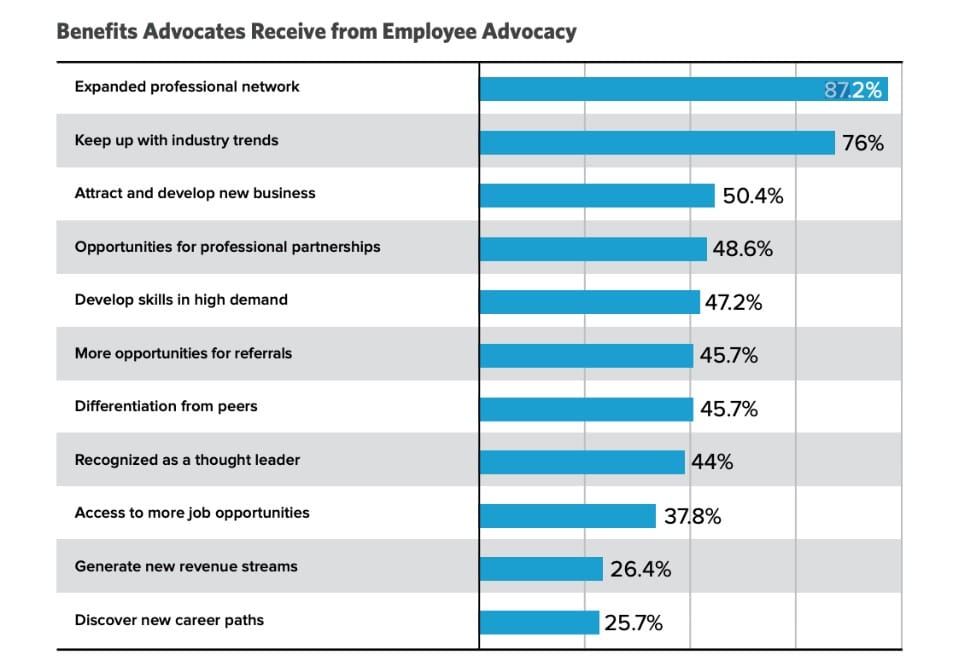If there’s one main place where people go to gather opinions about a company, it’s social media. With an estimated 4.9 billion social media users worldwide in 2023, there’s a huge audience just waiting to hear about you.
Of course, having an official brand account across multiple platforms is one way to handle this—but don’t overlook employee advocacy.

Employee advocacy is exactly what it sounds like: your staff acting as advocates for your brand. But if you really want to excel at this, you need to inform employees of relevant rules and provide them with the necessary skills to make the most of the opportunities presented by social media.
Your company’s reputation, compliance with privacy laws, and security of sensitive information are all at risk if you don’t properly train employees – so let’s take a look at how to get started.
How to conduct social media training for employees
Rather than starting with a company-wide initiative, spend some time identifying a small pool of candidates to start with. By doing this, you can test the waters and see what works, what doesn’t, and hone your training before rolling it out further.
Additionally, you may find some of your employees aren’t sure how social media training will benefit them. Having a trial run with a small group who can act as internal advocates will be much more effective than simply telling them.

Once you’ve picked out the right people, it’s time to get started.
1) Determine your objectives
Before training your employees on social media, you must know your goals and expectations. Setting clear objectives creates a sense of accomplishment for employees and can help you measure the impact of your training program.
Here are some points to consider when setting out your objectives:
- Are you trying to get them to spread the word about your company or highlight your company’s unique culture?
- Do you want to build brand awareness on social media platforms?
- Do you want to boost audience engagement with brand content?
By defining your objectives, you can identify the areas where employees need training. This allows you to target those areas for improvement and maximize the impact of the training program.
2) Create a social media policy
When employees are aware of clear rules, they will feel more secure posting company content and information. You need to lay out exactly what is and what isn’t acceptable. For example, a call center’s policy could discourage posting about the clients they handle, and focus more on useful topics like Vonage’s guide on call center management.
In any case, your business and industry will dictate the specifics of your social media policy. But here are a few general points to consider when drafting yours:
- Clearly state what type of content is acceptable and what isn’t
- Emphasize the importance of protecting confidential information, trade secrets, and proprietary data
- Specify the conditions for using company logos and other brand identifiers on personal accounts
- Provide guidance on handling negative feedback about the company
- Remind employees of their legal obligation to the company and that they are responsible for their actions online
3) Educate staff on best practices
The best training goes beyond simply protecting your brand reputation. The next step is to educate your staff on the best ways to use social media to improve it across each specific platform and demographic. Provide online courses, workshops, webinars, or coaching sessions on creating engaging content, using hashtags and keywords, and adapting to changes in trends and algorithms.
Consider areas of overlap with other departments. For instance, if you’re on a hiring spree, incorporate some training on diversity recruitment best practices to ensure that their online presence aligns with your HR department and your hiring goals.
4) Encourage employees to work on their online profiles
It’s not all about the brand, however. By enhancing their own profiles, employees can create a strong personal brand that complements both the individual and the company.
Employees with comprehensive social media profiles also help you boost your brand message on these platforms. This can contribute to creating a positive public perception of your brand as employees connect with clients, industry professionals, and even potential hires.

Sell the idea of building strong profiles by providing training on personal branding during the onboarding process. When you emphasize its importance to employees early on, they will be more comfortable taking on the responsibility of keeping their social media profiles in good shape.
5) Provide training on different tools
Within training on different tools, ensure that employees are proficient in using essential social media platforms and their features, as well as collaborative tools like a shared inbox for efficient communication and teamwork.
Additionally, introduce them to valuable resources such as social listening tools, access to analytics reports, and a BYOD solution (Bring Your Own Device). These tools and technologies are vital for maximizing your social media strategies and can greatly benefit your company.
Consider implementing an LMS solution (Learning Management System) to streamline the training process and track the progress of your employees as they learn to use these tools effectively.
Technology continues to transform the way we do business. We only have to consider innovative tools like a remote desktop iPad or VoIP tools for smartphones to see how technology has impacted the day-to-day workplace. However, these tools are only effective if employees know how to use them.
The same thing works for social media. Beyond the everyday social media tools available, there are other resources and functionalities that employees should know how to use.
For example, training your staff to use social listening tools and access analytics reports can help you use social media to your advantage. Knowing how these tools work gives employees a deeper understanding of social media strategies, which can only benefit your company.
To ensure continuous improvement in your employees’ skills, consider incorporating ongoing learning and development opportunities into your training program. This can help them stay up-to-date with the latest social media trends and tools, ensuring they remain effective in their roles.
Start training today
It is important for businesses, including PR professionals, to invest in social media if they want to thrive.
Having faith in staff to produce or distribute content benefits everyone involved. It helps you reach more people, reduces the burden on your social media team, and gives your employees more opportunities to promote themselves.
If you want to start achieving this, it’s time to implement robust social media training for employees in order to empower them with the skills and knowledge they need.








